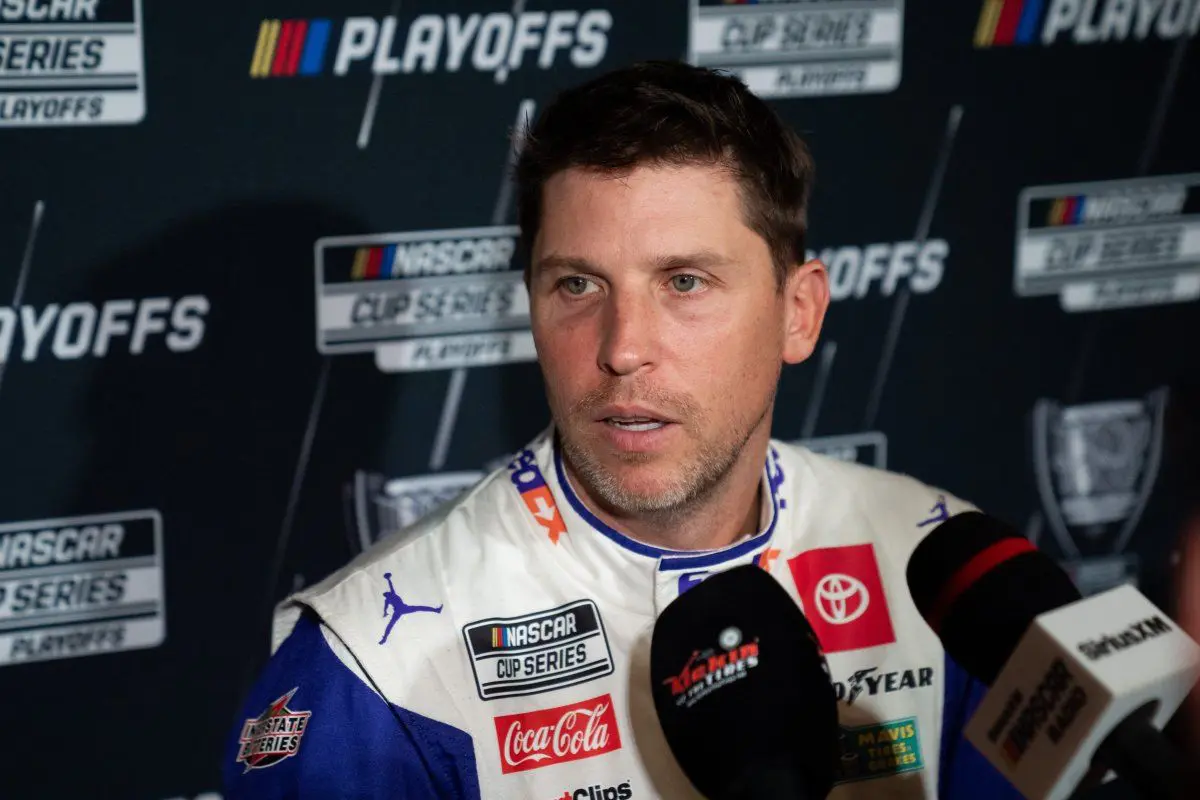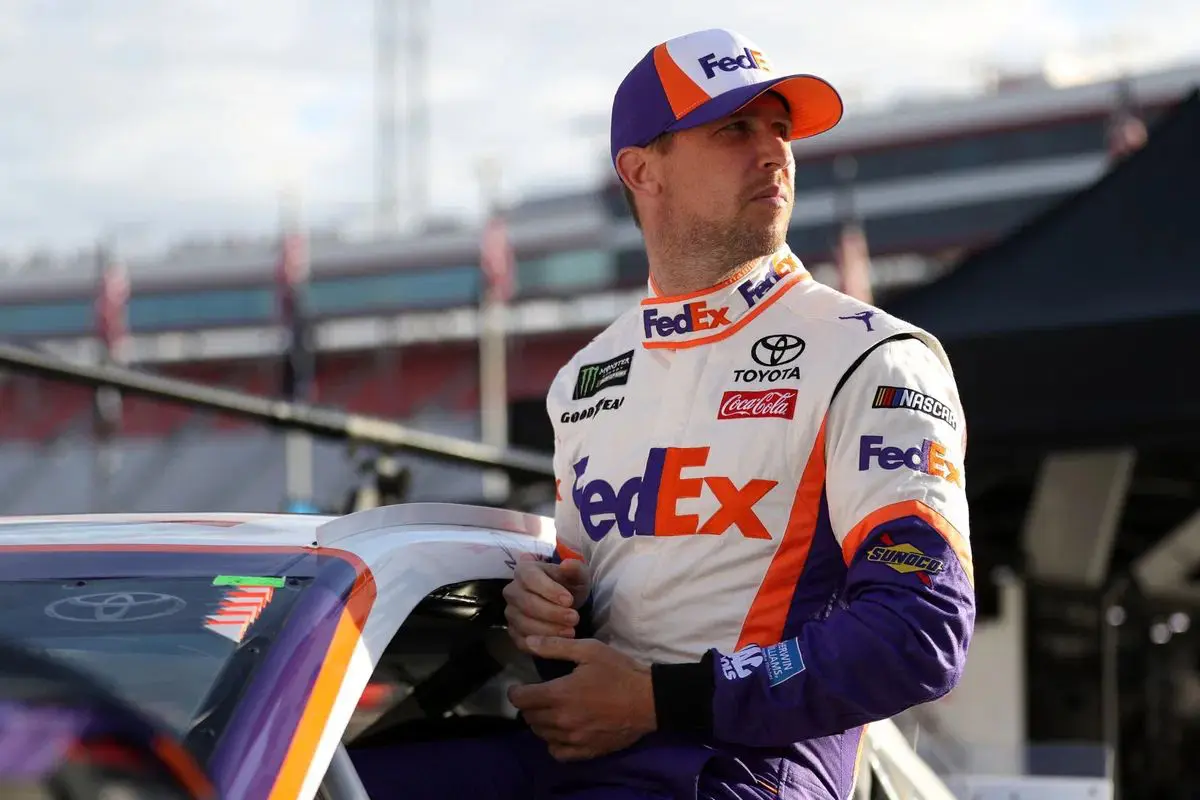Crew Chief Fed Up with Denny Hamlin: In the wake of a P23 finish at Atlanta, Denny Hamlin‘s crew chief, Chris Gabehart, has called for a radical shift in strategy, advocating for a “crash or race” mentality to improve competitiveness. This pivot highlights a growing urgency to accumulate critical playoff points as the team prepares for high-stakes races ahead. Gabehart’s critique of the previous conservative approach raises questions about the balance between risk and safety, prompting a reevaluation of how Hamlin can utilize his strengths, particularly on road courses. What implications will this aggressive strategy have for his performance in the upcoming races?
Key Highlights
- Denny Hamlin’s conservative strategy at Atlanta led to a disappointing P23 finish, his crew chief Chris Gabehart to urge a shift in tactics.
- Gabehart emphasized the need for aggressive racing to secure playoff points after missing stage points in Atlanta.
- Upcoming races at Daytona, Bristol, and Talladega require risk-taking to enhance competitiveness and capitalize on unique challenges.
- Historical trends in NASCAR highlight the importance of bold strategies, as conservative tactics can result in missed championship opportunities.
- Gabehart’s call for a “Crash or Race” approach seeks to align Hamlin’s performance with the urgency of playoff aspirations.
Denny Hamlin’s Conservative Strategy at Atlanta
Denny Hamlin’s cautious racing strategy at Atlanta Motor Speedway raised eyebrows among fans and analysts alike, as it sharply contrasted with the aggressive approach typically expected from a playoff contender. Entering the playoffs as a leading favorite, Hamlin’s decision to adopt a conservative racing style was perplexing, particularly involved in the opening Round of 16 race.
Throughout the event, Hamlin exhibited a reluctance to engage in battles for track position, opting instead for a strategy that prioritized safety over competitiveness. This decision culminated in a P23 finish, a noticeable departure from his usual performance levels. Hamlin’s approach seemingly stemmed from a desire to avoid potential wrecks, yet the irony lay in the fact that his attempts to mitigate risk ultimately led to a complete absence of stage points, a fundamental component for playoff advancement.
The consequences of this conservative strategy are substantial. Not only did it hinder his immediate standing in the playoff race, but it also prompted examination from his team, particularly his crew chief, Chris Gabehart, who now faces the challenge of recalibrating Hamlin’s tactics before the upcoming races.
“No, I don’t think so. I think that Chris is going to make me crash or race, so he’s not going to let me do that again.”-(HAMLIN)
With two races remaining prior to the Round of 12, the necessity for a decisive shift in strategy is . As Hamlin contemplates his next moves, the balance between safety and aggression will be essential in determining his fate in the playoffs. A reevaluation of his approach could prove imperative for his championship aspirations moving forward.
Hamlin’s Approach and Upcoming Races
Reassessing racing strategies becomes fundamental for Hamlin as he prepares for the impending challenges in the NASCAR playoffs. Following a disheartening performance at Atlanta, where a conservative approach yielded minimal gains, Hamlin must pivot towards more aggressive tactics. Criticism surrounding his cautious style highlights the requirement for a shift in mindset—one that accepts risk-taking to optimize potential rewards in upcoming races.
Hamlin’s strategy during the Atlanta race reflects a broader context, where securing points often requires a balance between self-preservation and seizing opportunities. As he looks forward, understanding the dynamics of the tracks and competitors will be pivotal.
With the playoff races looming, the time for calculated risks is now. Hamlin’s prior approach was rooted in a strategy that relied heavily on the misfortunes of others. However, as the competition intensifies, both the ability to adapt and the willingness to change will define Hamlin’s prospects.
The expectation now lies in his ability to blend aggression with strategy, ensuring that he not only competes but thrives amidst the pressures of the NASCAR playoffs.
Chris Gabehart’s Ultimatum and Hamlin’s Future Strategy
This shift from a conservative mindset to one that accepts risk is essential for Hamlin’s playoff aspirations. The implications of such a strategy resonate deeply within the competitive landscape of NASCAR, leaving fans and analysts alike to contemplate the stakes.
The potential outcomes of this approach can be distilled into several key factors:
- The urgency of securing playoff points
- The high stakes of a competitive field
- The psychological pressure on Hamlin to perform
- The potential for both triumph and failure
In consideration of Gabehart’s ultimatum, Hamlin must recalibrate his mindset. This call to action not only highlights the need for a more aggressive driving style but also underscores the inherent risks that come with it.
As the race at Talladega approaches, Hamlin’s ability to adapt will be tested, and the choices he makes could define his path in the playoffs. The balance between risk and reward is now at the forefront of his racing strategy, setting the stage for a pivotal juncture in his career.
Historical Context and the Need for Risk-Taking
In the context of NASCAR’s competitive history, the necessity for risk-taking becomes increasingly evident as drivers navigate the complexities of high-stakes racing. Denny Hamlin‘s longstanding pursuit of a championship title symbolizes this dynamic, particularly as he faces a critical juncture in the current season. With only two points separating him from playoff elimination, the urgency for a bold strategy is palpable.
Historical precedents demonstrate that conservative tactics can lead to missed opportunities; Hamlin’s experience during the 2019 season finale at Homestead-Miami serves as a cautionary tale. The team’s decision to employ a conservative approach ultimately resulted in overheating the car, costing them a shot at victory.
This season, with looming challenges at Watkins Glen and Bristol, Hamlin and crew chief Chris Gabehart must reevaluate their strategy. The ‘crash or race’ philosophy reflects an understanding that, in NASCAR, passivity can be fatal to championship aspirations. The sport’s history is rife with instances where drivers who accepted risk reaped considerable rewards, particularly in playoff scenarios where every point counts.
As Hamlin contemplates his next moves, the need for aggressive tactics becomes clear. Accepting risk not only aligns with the competitive spirit of NASCAR but also serves as a pragmatic response to the relentless pressure of the playoffs. Consequently, the call for risk-taking emerges not merely as a strategy but as a necessary evolution in the quest for a long-elusive championship.
Chris Gabehart’s Reaction and Hamlin’s Outlook for Watkins Glen
Although Chris Gabehart initially approached the playoff race at Atlanta with a plan for cautious driving, he was taken aback by Denny Hamlin‘s continued conservatism throughout the event. Gabehart expressed his surprise at Hamlin’s uncharacteristic behavior, noting that their pre-race agreement did not extend to the entire race. This unexpected caution raises critical questions about Hamlin’s mindset and strategy moving forward.
Gabehart stated, “I wish we would have changed our plan,” highlighting his desire for proactive communication with his veteran driver. The implications of Hamlin’s performance are notable, as they could dictate the path of the playoffs.
“I didn’t expect the rest of it to be as conservative as it was on his behalf, and we didn’t plan that together. I wish we would have changed our, I wish we would have. Had I known that was more of an issue in his head, I would have done my best to talk through the scenario ahead of time with him.”-(GABEHART)
As the series moves to Watkins Glen, Hamlin’s history at the road course offers a glimmer of hope:
- Strong finishes in previous races suggest potential for success.
- His runner-up finish last year shows his competitiveness.
- A pole position start indicates his capability to seize opportunities.
- Consistency in the top five positions reinforces his skill on road courses.
With Hamlin’s previous successes at Watkins Glen, there remains optimism despite the hurdles faced at Atlanta. The upcoming race will be pivotal, not only for securing a strong playoff position but also in determining how Hamlin adapts his racing strategy.
News in Brief: Crew Chief Fed Up with Denny Hamlin
Denny Hamlin’s recent performances, particularly the disappointing P23 finish at Atlanta, a tactical pivot towards a more aggressive racing philosophy appears vital for Denny Hamlin. The endorsement of a “crash or race” mentality by crew chief Chris Gabehart highlights the urgency to secure playoff points in upcoming races. Embracing risk-taking is critical for enhancing competitiveness, especially as Hamlin prepares for road courses like Watkins Glen, where leveraging strengths could yield notable rewards.
ALSO READ: Denny Hamlin’s Watkins Glen Strategy: The Role of Goodyear’s New Tires in His Victory Plan




